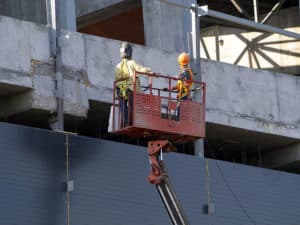When I first set down and began drafting this blog post, I started off with the intent to address the many different fall protection requirements for general industry and construction. But I decided to shift gears (don’t worry, I’ll cover the general requirements in a future blog) and instead focus on the fall protection requirements for one specific type of equipment where I see the most misunderstandings among employers and employees: aerial lifts.
Federal OSHA standards 1910.67 and 1926.453 address aerial lifts for general industry and construction (respectively). Both of those contain a specific requirement that “A body belt shall be worn and a lanyard attached to the boom or basket when working from an aerial lift.” However, it is what the standards don’t say that can cause confusion.
During inspections of work sites, I commonly see someone working in an aerial lift wearing a full-body harness with a six-foot fall arrest lanyard attached to a tie-off point in the basket or work platform. When I ask why they are wearing that equipment, most tell me they are required by OSHA to do so because should they fall out, their fall will be arrested. But nobody should just fall out of a work platform on an aerial lift because they come equipped with standard guardrails on all sides, coupled with the fact that the OSHA standards for aerial lifts require the worker to keep both feet on the floor of the work platform and forbids climbing up on the guardrails. Furthermore, if for some reason somebody did climb up on the guardrails and then fall out of the work platform of an aerial lift, there is a very good chance that the force generated when the worker hits the end of their six-foot lanyard could cause the whole lift to tip over and fall to the ground. And even if the aerial lift did not tip over when arresting the fall, the long lanyard could cause the falling worker to swing back towards and then strike the structure of the aerial lift, causing severe injuries. So workers in an aerial lift platform should not use a fall arrest system for protection unless the aerial lift and its attachment points have been specifically designed to meet the requirements of a fall arrest anchoring system.

Then why does OSHA require us to tie off in an aerial lift work platform that is already equipped with standard guardrails for fall protection? Two words; body restraint. Since the OSHA standards fail to explain why we must tie off, perhaps it would help if I make an attempt to explain why it is necessary. Anyone who has ever been standing in the platform of an extensible or articulating boom-lift that was driven over a bumpy surface or had the lifting control quickly shifted will tell you that these actions can cause the work platform to severely “bounce”, especially when the boom is positioned horizontally away from the machine base. And this bouncing action can in some cases cause the worker to be catapulted out of the work platform and fall to the ground below. To see how this can happen, you may want to view this short video sent to me by Mike Trumbature at Industrial Equipment Company in Houston.
To prevent this, the worker must wear a safety belt (yes, a body belt is still allowed for body restraint systems, just not for fall arrest systems) or full-body harness that is equipped with a short lanyard attached to the work platform (the manufacturers usually provide a designated tie-off point somewhere in the work platform), with it being imperative that the lanyard be of a length short enough to prevent the person from being ejected from the basket. In other words, this arrangement keeps you from being thrown out of the work platform, as opposed to catching you if for some reason you did fall out.
Being catapulted from the work platform of a boom-lift seems plausible, but some of you are probably wondering how a person could be catapulted from the platform of a scissor-lift, since it only moves up and down (vertically) and is therefore much less apt to bounce the worker out of the platform. And that is where mistake number two is commonly made. When you read the scope of the OSHA standards for aerial lifts (as well as the ANSI A92.2 standard upon which it is based), you will see they apply to extensible and articulating boom platforms (as well as ladder trucks and tower trucks), but they do not cover scissor-lifts. That is because scissor-lifts were actually covered in a different ANSI standard (A92.6), not adopted by OSHA as part of the aerial lift standard, and which does not require workers to be tied off with a lanyard unless the guardrails are removed from the platform of the scissor-lift. In fact, OSHA has no standard specifically addressing fall protection for workers in scissor-lifts, and usually refers to their scaffold standards as well as the scissor-lift manufacturer’s instructions for safety-related information.
OSHA issued a letter of interpretation that addresses the requirements for use of a body-restraint system on aerial lifts (body restraint is required) versus scissor-lifts (body restraint not required as long as standard guardrails are in place). One last thing about scissor-lifts to keep in mind; in some cases, the manufacturer of a scissor-lift may install a tie-off point(s) in the work platform. In those cases, you should consult their instructions for recommendations as to when it might be necessary to tie-off while using their equipment.
Hopefully this blog post helps clarify what the OSHA requirements are regarding who must (and must not) be tied off while working in the work platform of various types of lifts, and more importantly, why it is necessary. Again, I cannot stress enough the importance of using as short a lanyard as possible for the body restraint system, as the goal is to keep you from being ejected from the work platform or basket of a boom-lift.
If you have questions, comments or anything that you want to share on this topic, please scroll down to the Comments section below. And last but not least, I encourage you to Share This Blog Post with Others in Your Network who can benefit from this information. Thank you – Curtis

